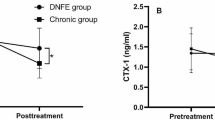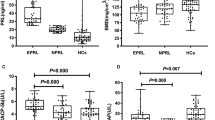Abstract
Summary
Low bone mineral density (BMD) is common among patients with schizophrenia; however, the pathogenesis is still unclear. Different types of antipsychotics may have different effects on BMD in inpatients with schizophrenia.
Introduction
This retrospective study aimed to evaluate the effects of prolactin-raising (PR) antipsychotics vs. clozapine combined with PR antipsychotics on BMD of patients with schizophrenia and analyzed clinically related factors that may affect BMD.
Methods
A total of 125 participants (males/females = 62/63) were included. Patients were treated with PR antipsychotics vs. clozapine combined with PR antipsychotics. They were similar in demographic and clinical characteristics. BMD was examined in their lumbar spine and proximal femur by a dual-energy X-ray (DEXA) absorption measurement device. Laboratory variables (including blood levels of prolactin, estradiol, testosterone, and cortisol) were collected.
Results
Among 125 inpatients with schizophrenia, the prevalence of osteoporosis and low BMD (including osteoporosis and osteopenia) was 26.4% and 64%. The average BMD T value in patients receiving clozapine combined with PR antipsychotics was significantly higher than in patients receiving PR antipsychotics (p < 0.05). Patients in the clozapine combined with PR antipsychotic group had higher testosterone levels than the PR antipsychotic group (Z = − 2.77, p = 0.006). Linear logistic regression analysis indicated that clozapine combined with PR antipsychotic treatment (p < 0.05) and higher estradiol level (p < 0.05) may be significantly associated with higher BMD.
Conclusions
Our results suggest that the use of clozapine may be a protective factor for low BMD induced by PR antipsychotics in inpatients with schizophrenia. The possible mechanism is that clozapine may protect BMD by regulating estrogen and testosterone levels, but the mechanism by which clozapine regulates these two sex hormones needs further investigation.
Similar content being viewed by others
References
Kishimoto T, De Hert M, Carlson HE et al (2012) Osteoporosis and fracture risk in people with schizophrenia. Curr Opin Psychiatry 25:415–429
Stubbs B, Gaughran F, Mitchell AJ, de Hert M, Farmer R, Soundy A, Rosenbaum S, Vancampfort D (2015) Schizophrenia and the risk of fractures: a systematic review and comparative meta-analysis. Gen Hosp Psychiatry 37:126–133
Kanis JA, McCloskey EV, Johansson H et al (2013) European guidance for the diagnosis and management of osteoporosis in postmenopausal women. Osteoporos Int 24:23–57
Stubbs B, De Hert M, Sepehry AA et al (2014) A meta-analysis of prevalence estimates and moderators of low bone mass in people with schizophrenia. Acta Psychiatr Scand 130:470–486
Hugenholtz GW, Heerdink ER, van Staa TP et al (2005) Risk of hip/femur fractures in patients using antipsychotics. Bone 37:864–870
Molitch (2005) Medication-induced hyperprolactinemia. Mayo Clin Proc 80:1050–1057
Crews MP (2012) Is antipsychotic treatment linked to low bone mineral density and osteoporosis? A review of the evidence and the clinical implications. Hum Psychopharmacol 27:15–23
WHO Study Group (1994) Assessment of fracture risk and its application to screening for postmenopausal osteoporosis: synopsis of a WHO report. Osteoporos Int 4:368–381
Milano W, Colletti C (2017) Hyperprolactinemia induced by antipsychotics: from diagnosis to treatment approach. Endocr Metab Immune Disord Drug Targets 17:38–55
Halbreich U (1996) Accelerated osteoporosis in psychiatric patients: possible pathophysiological processes. Schizophr Bull 22:447–454
Inder WJ (2011) Antipsychotic-induced hyperprolactinaemia. Aust N Z J Psychiatry 45:830–837
Cui J, Liu H, Shao J, Xu DM, Wang Y, Fei Z, Wei J, Lu W, Wang CR, He R, Tan Y, Fan Y, Ning Y, Cassidy RM, Soares JC, Huang X, Zhang XY (2018) Prevalence, risk factors and clinical characteristics of osteoporosis in Chinese inpatients with schizophrenia. Schizophr Res 195:488–494
Lin CH, Lin CY, Wang HS (2019) Long-term use of clozapine is protective for bone density in patients with schizophrenia. Sci Rep 9:3895
Jones PB, Barnes TR, Davies L et al (2006) Randomized controlled trial of the effect on quality of life of second- vs first-generation antipsychotic drugs in schizophrenia: Cost Utility of the Latest Antipsychotic Drugs in Schizophrenia Study (CUtLASS 1). Arch Gen Psychiatry 63:1079–1087
Lewis SW, Barnes TR, Davies L et al (2006) Randomized controlled trial of effect of prescription of clozapine versus other second-generation antipsychotic drugs in resistant schizophrenia. Schizophr Bull 32:715–723
Correll CU, Rummel-Kluge C, Corves C, Kane JM, Leucht S (2009) Antipsychotic combinations vs monotherapy in schizophrenia: a meta-analysis of randomized controlled trials. Schizophr Bull 35:443–457
Lehman AF, Lieberman JA, Dixon LB et al (2004) Practice guideline for the treatment of patients with schizophrenia, second edition. Am J Psychiatry 161:1–56
Araoye M (2004) Sample size determination. Research methodology with statistics for health and social sciences. Nathadex Publishers, Ilorin
Gardner DM, Murphy AL, O'Donnell H, Centorrino F, Baldessarini RJ (2010) International consensus study of antipsychotic dosing. Am J Psychiatry 167:686–693
Andreasen NC, Pressler M, Nopoulos P, Miller D, Ho BC (2010) Antipsychotic dose equivalents and dose-years: a standardized method for comparing exposure to different drugs. Biol Psychiatry 67:255–262
Hartling L, Abou-Setta AM, Dursun S, Mousavi SS, Pasichnyk D, Newton AS (2012) Antipsychotics in adults with schizophrenia: comparative effectiveness of first-generation versus second-generation medications: a systematic review and meta-analysis. Ann Intern Med 157:498–511
Patel MX, Arista IA, Taylor M (2013) How to compare doses of different antipsychotics: a systematic review of methods. Schizophr Res 149:141–148
Davis JM (1974) Dose equivalence of the antipsychotic drugs. J Psychiatr Res 11:65–69
Kanis JA, Adachi JD, Cooper C et al (2013) Standardising the descriptive epidemiology of osteoporosis: recommendations from the Epidemiology and Quality of Life Working Group of IOF. Osteoporos Int 24:2763–2764
Kinon BJ, Gilmore JA, Liu H (2003) Prevalence of hyperprolactinemia in schizophrenic patients treated with conventional antipsychotic medications or risperidone. Psychoneuroendocrinology 28:55–68
Khosla S, Oursler MJ (2012) Estrogen and the skeleton. Trends Endocrinol Metab 23:576–581
Kinon BJ, Ahl J, Liu-Seifert H (2006) Improvement in hyperprolactinemia and reproductive comorbidities in patients with schizophrenia switched from conventional antipsychotics or risperidone to olanzapine. Psychoneuroendocrinology 31:577–588
Abraham G, Paing WW, Kaminski J, Joseph A, Kohegyi E, Josiassen RC (2003) Effects of elevated serum prolactin on bone mineral density and bone metabolism in female patients with schizophrenia: a prospective study. Am J Psychiatry 160:1618–1620
Felson DT, Zhang Y, Hannan MT (1993) Effects of weight and body mass index on bone mineral density in men and women: the Framingham study. J Bone Miner Res 8:567–573
Liu-Seifert H, Kinon BJ, Ahl J (2004) Osteopenia associated with increased prolactin and aging in psychiatric patients treated with prolactin-elevating antipsychotics. Ann N Y Acad Sci 1032:297–298
Renn JH, Yang NP, Chueh CM, Lin CY, Lan TH, Chou P (2009) Bone mass in schizophrenia and normal populations across different decades of life. BMC Musculoskelet Disord 10:1
Ho ML, Tsai TN, Chang JK, Shao TS, Jeng YR, Hsu C (2005) Down-regulation of N-methyl D-aspartate receptor in rat-modeled disuse osteopenia. Osteoporos Int 16:1780–1788
Schwieler L, Linderholm KR, Nilsson-Todd LK, Erhardt S, Engberg G (2008) Clozapine interacts with the glycine site of the NMDA receptor: electrophysiological studies of dopamine neurons in the rat ventral tegmental area. Life Sci 83:170–175
Gray L, van den Buuse M, Scarr E, Dean B, Hannan AJ (2009) Clozapine reverses schizophrenia-related behaviours in the metabotropic glutamate receptor 5 knockout mouse: association with N-methyl-D-aspartic acid receptor up-regulation. Int J Neuropsychopharmacol 12:45–60
Lane HY, Huang CL, Wu PL, Liu YC, Chang YC, Lin PY, Chen PW, Tsai G (2006) Glycine transporter I inhibitor, N-methylglycine (sarcosine), added to clozapine for the treatment of schizophrenia. Biol Psychiatry 60:645–649
Naliato EC, Farias ML, Braucks GR et al (2005) Prevalence of osteopenia in men with prolactinoma. J Endocrinol Investig 28:12–17
Riggs BL, Khosla S (2002) Sex steroids and the construction and conservation of the adult skeleton. Endocr Rev 23:279–302
Torjesen PA (2004) Serum testosterone in women as measured by an automated immunoassay and a RIA. Clin Chem 50:678 author reply 678-679
Chin KY (2015) The effects of orchidectomy and supraphysiological testosterone administration on trabecular bone structure and gene expression in rats. Aging Male 18:60–66
Kinon BJ, Liu-Seifert H, Stauffer VL (2013) Bone loss associated with hyperprolactinemia in patients with schizophrenia. Clin Schizophr Relat Psychoses 7:115–123
Nikolić T, Petronijević M, Sopta J et al (2017) Haloperidol affects bones while clozapine alters metabolic parameters - sex specific effects in rats perinatally treated with phencyclidine. BMC Pharmacol Toxicol 18:65
Dickson RA, Seeman MV, Corenblum B (1999) Hormonal side effects in women: typical versus atypical antipsychotic treatment. J Clin Psychiatry 61:10–15
Bulut SD, Bulut S, Atalan DG, Tulaci RG, Türker T, Gürçay E, Aydemir Ç (2016) The effect of antipsychotics on bone mineral density and sex hormones in male patients with schizophrenia. Psychiatr Danub 28:255–262
Funding
This study was funded by Key Diagnosis and Treatment Program of Suzhou (LCZX201515), Introduction Project of Suzhou Clinical Expert Team (SZYJTD201715), Suzhou Key Medical Center for Psychiatric Diseases (Szzx201509), and Suzhou Science and Technology Project (SS201881).
Author information
Authors and Affiliations
Corresponding author
Ethics declarations
Conflicts of interest
None.
Statement of human rights
All procedures performed in studies involving human participants were following the ethical standards of the institutional and/or national research committee and with the 1964 Helsinki declaration and its later amendments or comparable ethical standards.
Additional information
Publisher’s note
Springer Nature remains neutral with regard to jurisdictional claims in published maps and institutional affiliations.
Rights and permissions
About this article
Cite this article
Qiu, J., Gong, H., Wang, B. et al. The use of clozapine is protective for low bone mineral density induced by prolactin-raising antipsychotics in inpatients with schizophrenia. Arch Osteoporos 15, 98 (2020). https://doi.org/10.1007/s11657-020-00771-y
Received:
Accepted:
Published:
DOI: https://doi.org/10.1007/s11657-020-00771-y




